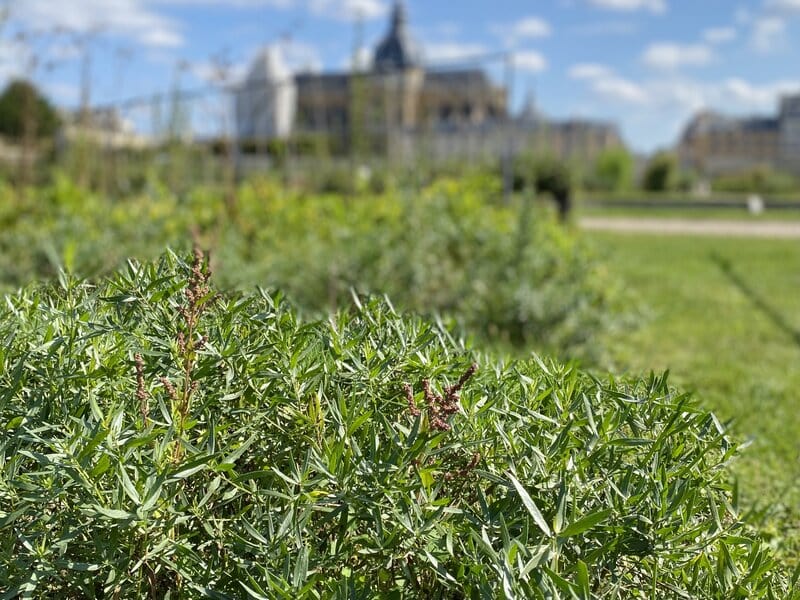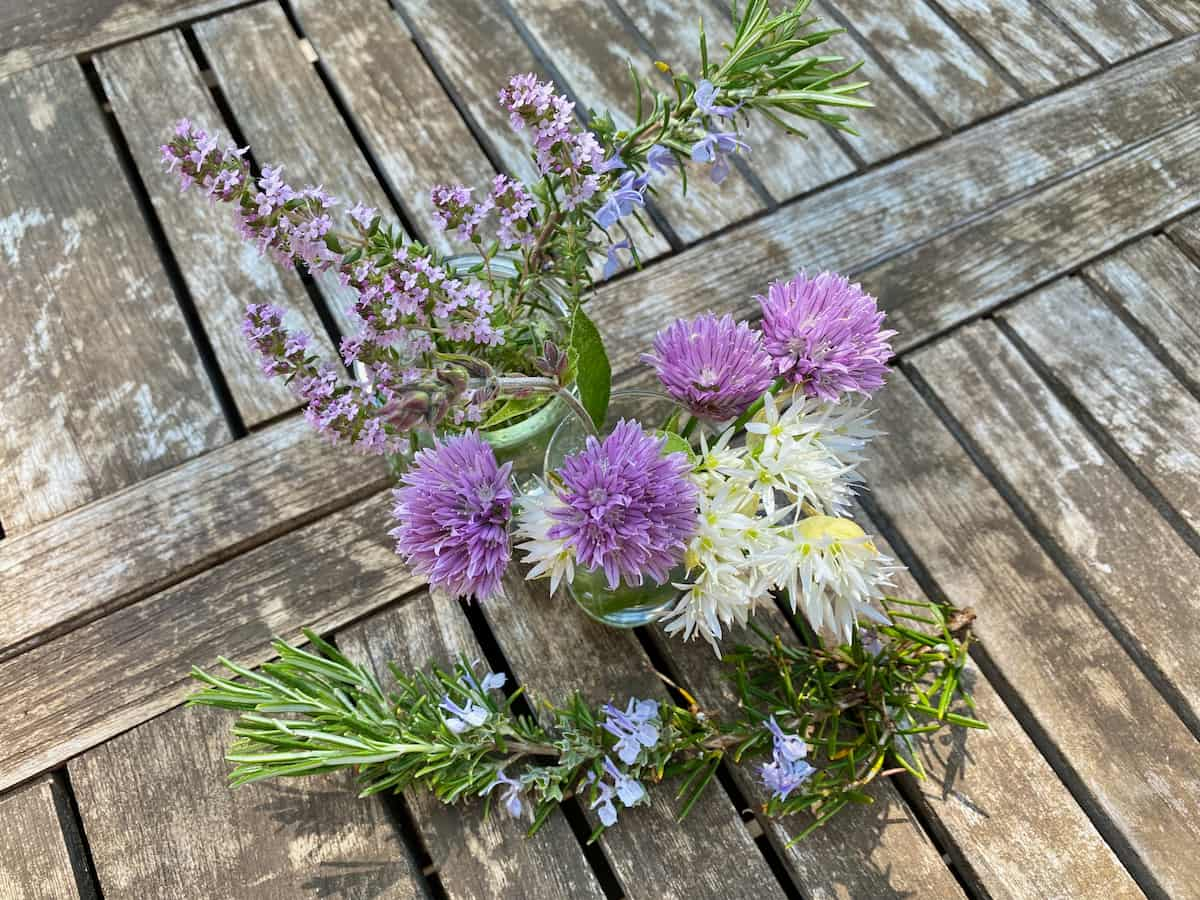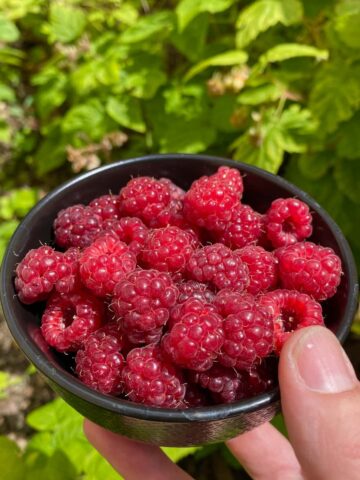Guide to using the most common herbs in cooking, particularly in French cuisine. How to prepare, store and the best to use for chicken, fish, cheese, eggs and sauces. Also recommendations for eating herb flowers and how to use them.

What are the best fresh herbs to have on hand?
The following are the most common fresh herbs and popular in the French kitchen. The following herbs are excellent for vegetable dishes, for chicken, steaks, fish, eggs and sauces, depending on the type of dish served. Available particularly between April to October, although rosemary, mint and thyme are available all year round. More on each of their individual characteristics in the guide below:
- Parsley (persil) - perhaps the most widely used and comes in both flat (plat) or curly (frisée). Curly is usually for garnish and flat is more widely used for cooking and adding to salads. Particularly good with fish and seafood for its almost grassy flavour that doesn't overwhelm the taste of the dish. Best added at the end of cooking to preserve its natural benefits of vitamin C and flavour;
- Basil (basilic) - known for its pungeant sweet tones and taste of summer, particularly good with fresh pasta and salads, it's the main ingredient in the provençal pistou (French equivalent of pesto without nuts or cheese). Also excellent with a little added to strawberries;
- Mint (menthe) - Perfect in savoury as well as desserts and cocktails. Also a typical taste of Corsica. Excellent in this mint omelette and added to this spinach and ricotta lasagna, it transforms an ordinary dish into something special;
- Rosemary (romarin) - it's a typical piney taste of Provence with a powerful flavour that brings out the flavours in cheese dishes. Add a branch of it to a cheese or charcuterie board - excellent paired with goat's cheese and a must ingredient in a warm goat's cheese salad or a goat's cheese & walnut sauce for pasta.
- Thyme (thym) - If you have thyme on your hands, you know it's quite a strong herb so use sparingly. Good for chicken dishes. Also known for its slightly milder lemon thyme, this is lovely with fish and lemon and lime dishes.
- Coriander/Cilantro (Coriandre) - the celebrity herb of Asian inspired dishes, curries and any taste of the exotic. An important ingredient in this Moroccan Chicken and Prune Tagine;
- Tarragon (estragon) - one of the main ingredients in the classic Sauce Béarnaise;
- Chives (ciboulette) - from the Allium family, also known as onion chives. For a subtle taste of onion, finely chop into egg or chicken dishes. Its edible flowers (see below) are also delicious added before serving;
- Sage (sauge) - powerful herb leaves that are particularly delicious with pumpkin or squash savoury dishes.

Typical Aromatic Herbs used in French Cuisine
- Chervil (cerfeuil) - so subtle and pretty as delicious decor on just about any dish. One of the ingredients in a Béarnaise sauce but also transforms this pure vegetable soup.
- Bay Leaf (laurier); Bay leaves are dried to concentrate their subtle flavour in stews and added to a bouquet garni (see below). Also great in pickled radishes.
- Dill (aneth) - particularly good with fish and egg dishes, dill leaves are also a healthy addition as delicious decor as they are said to reduce cholesterol and improve heart health.
- Lavender (lavande) - A strong flower like thyme that should be used sparingly. Perfect pairing with apricots - try adding a little to this apricot and lavender jam.
- Lemon Verbena (verveine citronné) - Its delicate fresh leaves are also known as lemon balm and refreshing served with strawberries, in a raspberry clafoutis and in this lemon verbena ice cream with roasted peaches. Verveine is such a French classic, served as a night-time infusion either with fresh leaves or dried.
- Origano (origan) - more popular in Italian cuisine and a must on top of pizzas; less popular in French cuisine.
- Borage (bourrache) - use the herb flowers (see more below) for decor - delicious taste of subtle cucumber and preferable on salads. Pretty on desserts on books but from personal experience only good to taste on savoury dishes!
- Sorrel (oseille) - slightly bitter leaves that are traditionally made into a sauce to serve with salmon.
- Nettles (orties) - foraging for stinging nettles is so healthy and budget friendly. For more on how to pick and prepare nettles without being stung, see my recipe post for nettle pesto.

What is in a Bouquet Garni?
Many slow-cooked dishes use a Bouquet Garni (literally a 'garnished bouquet') of aromatic fresh herbs. Usually tied together with string, this is to stop the herbs from moving around the dish plus makes it easy to discard before serving. According to Larousse Gastronomique, the bouquet garni is basically composed of 2-3 stalks of fresh parsley, a branch of thyme and 1 or 2 dried bay leaves. In Provence, rosemary is used.
However, this can vary depending on local sources: adding a leek, sage or celery stalk can also be used. Popular stew recipes which include a Bouquet Garni are Blanquette de Veau, Monkfish stew, Corsican Veal Stew with Peppers, for example.
Most importantly, these bouquet garni herbs are added at the start of cooking as their flavours are particularly strong. Their essential oils can support the heat during slow cooking.
Conversely, most other herbs (parsley in particular) lose their flavour if cooked over 45°C-50°C - hence why we add most chopped herbs at the end of cooking to impart their flavour. Raphaël Haumont talks more about this fascinating subject in Les Papilles du Chimiste.

Best Fresh Herbs to Air Dry
Lavender, lemon verbena, and bay leaves are the easiest to air dry. Simply wash and dry them first and spread out on a kitchen towel and leave to air dry naturally over about a week. When dried, seal in sterilised jam jars or a biscuit tin and use within a year to 18 months.
For a teaspoon of fresh herbs asked for in cooking, use only a ¼ teaspoon if using dried herbs.

How to Store Fresh Herbs
Wrap the herb stalks in a humid paper towel and store in the vegetable drawer at the bottom of the fridge for 3-4 days.
Keep parsley stored in a long glass of water in the fridge, as I find it lasts even longer.

Can You Eat Herb Flowers?
You can absolutely eat herb flowers. Many people push them to the side as pretty useless garnish in restaurants but they are usually there for a reason: they're delicious! Contrary to popular belief, they don't taste like decorative flowers. Instead they are subtle and taste a mild version of the herb they come from.
Usually associated with the flavours of the dish, they are not only edible but they have a mild taste of the herb (surprise!). Gardeners tell us to trim herbs before flowers can appear but I personally prefer to wait until the flowers arrive in late Spring.
Herbs with Purple Flowers
The purple flowers of chives, for example, are pretty powerful if eaten as the whole flower. Instead, break up the little bell flowers and sprinkle on top of a plate of pasta. Sauté asparagus and chopped garlic in some butter and olive oil (as indicated how to cook asparagus), toss into spaghetti and top with chopped parsley, chive and thyme flowers.
Herb flowers can transform an ordinary dish to restaurant worthy. Try it with white basil flowers, purple rosemary or sage flowers (both almost orchid-like), to the tiny purple thyme flowers and borage (both white and purple).
Borage flowers are pretty on desserts (but personally feel they're not suited). Eaten in savoury dishes, borage taste a little bit like fresh cucumber - add it to this asparagus puff pastry tart.

More Recipes Using Herbs as a Main Ingredient
These recipes need the following fresh aromatic herbs as the main ingredient. If these herbs are not available, the dish is not at all the same.

Basil is one of the main authentic ingredients in the French classic Niçoise Salad.

Another classic French salad is the Salade de chèvre chaud. Warmed goat cheese is given a Provençal aromatic touch with bay leaves, fresh rosemary, thyme or dried herbes de Provence.

Add a variety of fresh herbs to make the most versatile yet simple green salad. Use your favourite seasonal veggies at any time of year and adapt the herbs to what you're serving it with.
Use fresh lemon thyme in this herb-crusted salmon dish. The crumble topping is rolled out, chilled and cut into rectangles on top of fish or chicken and clings beautifully under the grill.

Stuffed zucchini (courgettes farcies) are made Corsican style with the surprising and important ingredient: fresh mint. Add mint to many other dishes from Corsica to give a taste of the island, such as Corsican Cheese Lasagna (based on Cannelloni au brocciu).

plus mint is the main, yet surprising, ingredient in a Corsican Mint Omelette.

There are so many recipes that use fresh herbs on le blog, with flat leaf parsley as the main celebrity. I'll leave you to browse all the rest and enjoy via the recipe index.







